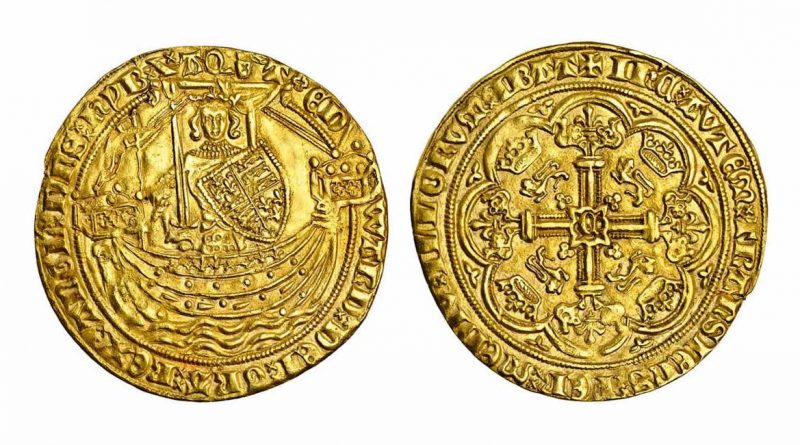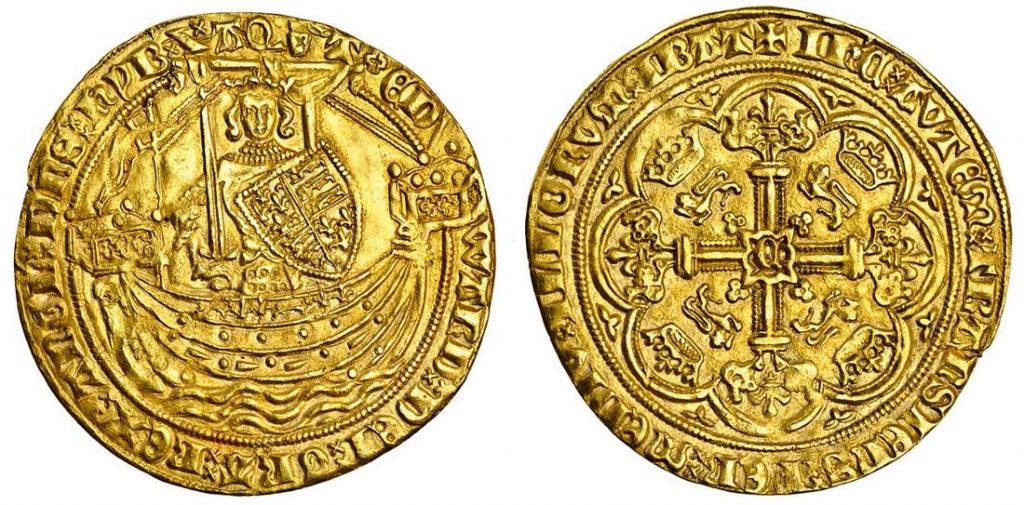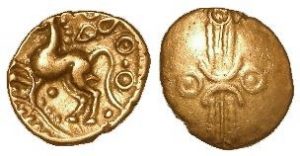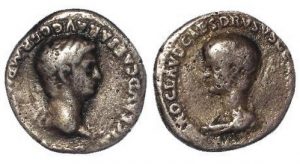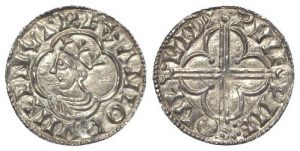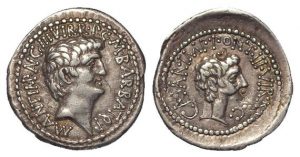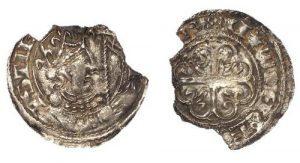Lockdales, Coins and Militaria, 27/28 March
Lockdales, Coins and Militaria, 27/28 March
Lockdales held an auction of coins and militaria on 27-28 March 2021. The sale included Roman and British hammered coins, including part II of the Isabella collection of short cross pennies. There are also several later gold coins. The auction catalogue is available here.
In addition to the hammer price, there is a Buyer’s Premium of 21.6% (inc VAT).
Highlighted Lot
Lot 1854, Edward III Noble
Edward III gold noble, Fourth Coinage, “Treaty B” Calais type C
Introduction of the noble
In August 1344, Edward III decided to strike a gold unit of 80 pence to be called the noble. The contract for the new coinage was awarded to a Perceval de Porche, from Lucca, Italy. If this was his design, he produced a masterpiece, which persisted in a similar form to the reign of James I. The design combined the four most popular symbols of England at the time, following the famous sea victory at Sluys in 1340: the king, ship, sword and power of the sea.
Treaty Period
Following the Treaty of Bretigny in 1360, Edward relinquished his claim to the French throne and this title was removed from his coinage. The Treaty of Bretigny was abrogated on 3 June 1369 and dies made subsequent to that date had the French title restored. Mules exist of Treaty and post-Treaty dies, indicating that Treaty nobles could have been struck for a short period after the Treaty ended, from the existing dies.
Treaty B coinage
Treaty period coinage can be divided into Treaty A and Treaty B. Treaty A coinage had the same poor style and finish of previous coins, the quality of which had been steadily deteriorating. On 18 June 1361, Robert de Porche (presumably a kinsman of Perceval) was appointed to reorganise the wok of the Tower mint.
The Treaty B coinage represents the highest level of workmanship reached during the reign of Edward III. The evidence of a clean break from the Treaty A coinage is the lack of mules of the two. As this coin demonstrates, Treaty B nobles can be distinguished by their neat design, well-proportioned ship, “ED” above the bowsprit and the young smiling face of the king. In addition the king’s Aquitaine title is shown as AQT rather than AQVTA or ACQ on the Treaty A noble.
Calais Mint
In February 1363, Calais mint was opened. It’s gold coin production was about 75% of the Tower mint.
Calais nobles are distinguished from the Tower coins by the C (for Calais) in the centre of the reverse, in place of E (for Edward). Calais nobles can also have a flag flying from the after-castle of the ship, as this coin does.
Lawrence's Calais types
In The Coinage of Edward III From 1351, (1933) , Lawrence classified Calais Nobles into 4 types. This is type C, shown by the voided quatrefoil before ED and the saltires either side of the retrograde Z.
Estimate
Estimate: £6,000 – £8,000
Hammer: £7,600
References
Lawrence, L. A. “THE COINAGE OF EDWARD III FROM 1351. Part IV.” The Numismatic Chronicle and Journal of the Royal Numismatic Society, vol. 13, no. 49, 1933, pp. 15–79.
POTTER, W. J. W. “THE GOLD COINAGES OF EDWARD III: PART II. (A) THE TREATY PERIOD (1361-9).” The Numismatic Chronicle and Journal of the Royal Numismatic Society, vol. 4, 1964, pp. 305–318
Dolley, R. H. M. “MASTER PERCIVAL DE PORCHE OF ‘LUK’—ITALIAN OR LIÉGEOIS?” The Numismatic Chronicle and Journal of the Royal Numismatic Society, vol. 5, 1965, pp. 201–203
Selected lots
Below are my picks from the other lots.
All images are © Lockdales. Click an image to enlarge

